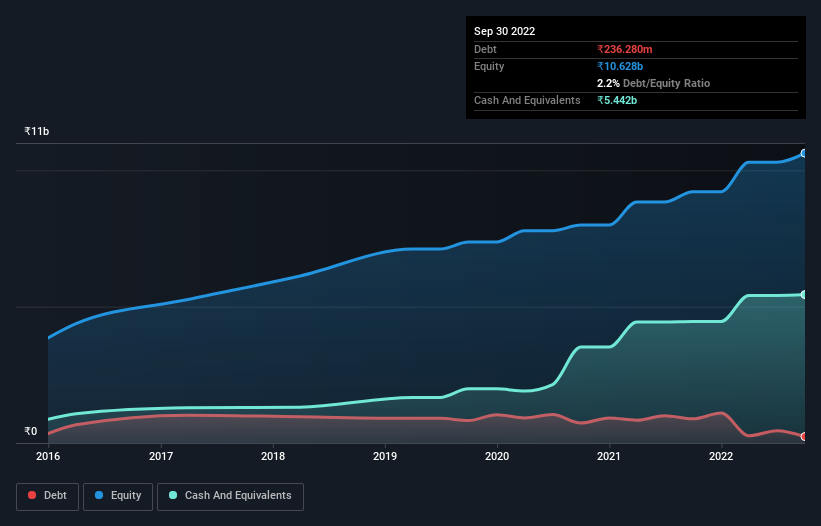These 4 Measures Indicate That Cera Sanitaryware (NSE:CERA) Is Using Debt Safely

David Iben put it well when he said, 'Volatility is not a risk we care about. What we care about is avoiding the permanent loss of capital.' When we think about how risky a company is, we always like to look at its use of debt, since debt overload can lead to ruin. Importantly, Cera Sanitaryware Limited (NSE:CERA) does carry debt. But the real question is whether this debt is making the company risky.
When Is Debt A Problem?
Generally speaking, debt only becomes a real problem when a company can't easily pay it off, either by raising capital or with its own cash flow. Part and parcel of capitalism is the process of 'creative destruction' where failed businesses are mercilessly liquidated by their bankers. However, a more usual (but still expensive) situation is where a company must dilute shareholders at a cheap share price simply to get debt under control. Of course, plenty of companies use debt to fund growth, without any negative consequences. When we examine debt levels, we first consider both cash and debt levels, together.
Check out the opportunities and risks within the IN Building industry.
What Is Cera Sanitaryware's Debt?
The image below, which you can click on for greater detail, shows that Cera Sanitaryware had debt of ₹236.3m at the end of September 2022, a reduction from ₹885.6m over a year. But it also has ₹5.44b in cash to offset that, meaning it has ₹5.21b net cash.

How Strong Is Cera Sanitaryware's Balance Sheet?
We can see from the most recent balance sheet that Cera Sanitaryware had liabilities of ₹3.38b falling due within a year, and liabilities of ₹922.5m due beyond that. Offsetting this, it had ₹5.44b in cash and ₹1.41b in receivables that were due within 12 months. So it actually has ₹2.55b more liquid assets than total liabilities.
This short term liquidity is a sign that Cera Sanitaryware could probably pay off its debt with ease, as its balance sheet is far from stretched. Succinctly put, Cera Sanitaryware boasts net cash, so it's fair to say it does not have a heavy debt load!
On top of that, Cera Sanitaryware grew its EBIT by 56% over the last twelve months, and that growth will make it easier to handle its debt. The balance sheet is clearly the area to focus on when you are analysing debt. But it is future earnings, more than anything, that will determine Cera Sanitaryware's ability to maintain a healthy balance sheet going forward. So if you're focused on the future you can check out this free report showing analyst profit forecasts.
Finally, while the tax-man may adore accounting profits, lenders only accept cold hard cash. While Cera Sanitaryware has net cash on its balance sheet, it's still worth taking a look at its ability to convert earnings before interest and tax (EBIT) to free cash flow, to help us understand how quickly it is building (or eroding) that cash balance. During the last three years, Cera Sanitaryware generated free cash flow amounting to a very robust 81% of its EBIT, more than we'd expect. That positions it well to pay down debt if desirable to do so.
Summing Up
While we empathize with investors who find debt concerning, you should keep in mind that Cera Sanitaryware has net cash of ₹5.21b, as well as more liquid assets than liabilities. And it impressed us with free cash flow of ₹1.0b, being 81% of its EBIT. So is Cera Sanitaryware's debt a risk? It doesn't seem so to us. Over time, share prices tend to follow earnings per share, so if you're interested in Cera Sanitaryware, you may well want to click here to check an interactive graph of its earnings per share history.
Of course, if you're the type of investor who prefers buying stocks without the burden of debt, then don't hesitate to discover our exclusive list of net cash growth stocks, today.
If you're looking to trade Cera Sanitaryware, open an account with the lowest-cost platform trusted by professionals, Interactive Brokers.
With clients in over 200 countries and territories, and access to 160 markets, IBKR lets you trade stocks, options, futures, forex, bonds and funds from a single integrated account.
Enjoy no hidden fees, no account minimums, and FX conversion rates as low as 0.03%, far better than what most brokers offer.
Sponsored ContentNew: AI Stock Screener & Alerts
Our new AI Stock Screener scans the market every day to uncover opportunities.
• Dividend Powerhouses (3%+ Yield)
• Undervalued Small Caps with Insider Buying
• High growth Tech and AI Companies
Or build your own from over 50 metrics.
Have feedback on this article? Concerned about the content? Get in touch with us directly. Alternatively, email editorial-team (at) simplywallst.com.
This article by Simply Wall St is general in nature. We provide commentary based on historical data and analyst forecasts only using an unbiased methodology and our articles are not intended to be financial advice. It does not constitute a recommendation to buy or sell any stock, and does not take account of your objectives, or your financial situation. We aim to bring you long-term focused analysis driven by fundamental data. Note that our analysis may not factor in the latest price-sensitive company announcements or qualitative material. Simply Wall St has no position in any stocks mentioned.
About NSEI:CERA
Cera Sanitaryware
Provides sanitary ware and faucet ware products in India.
Flawless balance sheet established dividend payer.
Market Insights
Community Narratives



